
A graphic novel is a long-form, fictional work of sequential art. The term graphic novel is often applied broadly, including fiction, non-fiction, and anthologized work, though this practice is highly contested by comics scholars and industry professionals. It is, at least in the United States, typically distinct from the term comic book, which is generally used for comics periodicals and trade paperbacks.
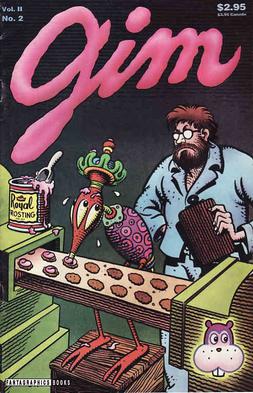
Jim is a comic book series by Jim Woodring. It began in 1980 as a self-published zine and was picked up by Fantagraphics Books in 1986 after cartoonist Gil Kane introduced Woodring to Fantagraphics co-owner Gary Groth. The publisher released four magazine-sized black-and-white issues starting in September 1987. A comic book-sized continuation, Jim Volume II, with some color, began in 1993 and ran for six issues until 1996.
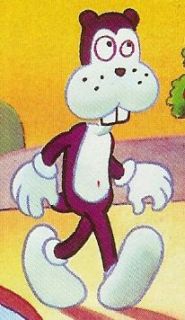
Frank is a cartoon character created by American cartoonist Jim Woodring. Frank is a bipedal, bucktoothed animal of uncertain species whom Woodring described as a "generic anthropomorph". The stories and supporting characters appear in a world called the Unifactor.
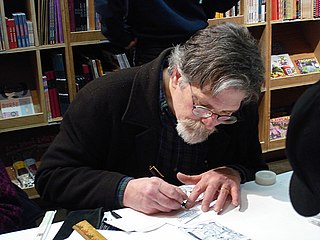
James William Woodring is an American cartoonist, fine artist, writer and toy designer. He is best known for the dream-based comics he published in his magazine Jim, and as the creator of the anthropomorphic cartoon character Frank, who has appeared in a number of short comics and graphic novels.

Franklin Christenson "Chris" Ware is an American cartoonist known for his Acme Novelty Library series and the graphic novels Jimmy Corrigan, the Smartest Kid on Earth (2000), Building Stories (2012) and Rusty Brown (2019). His works explore themes of social isolation, emotional torment and depression. He tends to use a vivid color palette and realistic, meticulous detail. His lettering and images are often elaborate and sometimes evoke the ragtime era or another early 20th-century American design style.

Brian Michael Bendis is an American comic book writer and artist.

David John Mazzucchelli is an American comics artist and writer, known for his work on seminal superhero comic book storylines Daredevil: Born Again and Batman: Year One, as well as for graphic novels in other genres, such as Asterios Polyp and City of Glass: The Graphic Novel. He is also an instructor who teaches comic book storytelling at the School of Visual Arts in Manhattan.
An autobiographical comic is an autobiography in the form of comic books or comic strips. The form first became popular in the underground comix movement and has since become more widespread. It is currently most popular in Canadian, American and French comics; all artists listed below are from the U.S. unless otherwise specified.

It's a Good Life, If You Don't Weaken is a graphic novel by Canadian cartoonist Seth. It appeared in a collected volume in 1996 after serialization from 1993 to 1996 in issues #4–9 of Seth's comic book series Palookaville. The mock-autobiographical story tells of its author's obsessive search for the work of a fictional forgotten cartoonist.
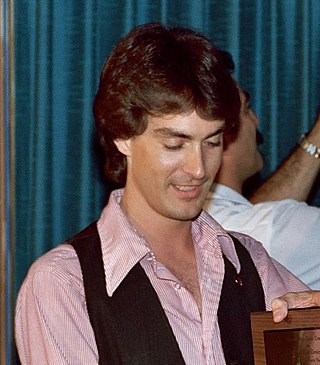
Dave Lee Stevens was an American illustrator and comics artist. He was most famous for creating The Rocketeer comic book and film character, and for his pin-up style "glamour art" illustrations, especially of model Bettie Page. He was the first to win Comic-Con International's Russ Manning Most Promising Newcomer Award in 1982, and received both an Inkpot Award and the Kirby Award for Best Graphic Album in 1986.

Steve Niles is an American comic book author and novelist, known for works such as 30 Days of Night, Criminal Macabre: A Cal McDonald Mystery, Simon Dark, Mystery Society, and Batman: Gotham County Line.
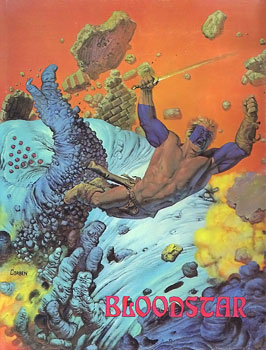
Bloodstar is an American fantasy comic book published in 1976. Possibly the first graphic novel to call itself a “graphic novel” in print, it was based on a short story by Robert E. Howard, the creator of Conan the Barbarian, and illustrated by fantasy artist Richard Corben. The book was published by The Morning Star Press in a limited signed and numbered edition.
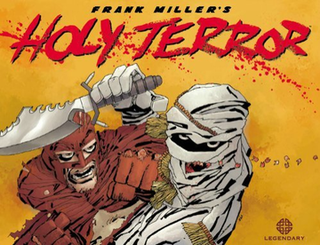
Holy Terror is a 2011 graphic novel by Frank Miller which follows a costumed vigilante named The Fixer as he battles Islamic terrorists after an attack on Empire City. The graphic novel was originally proposed as a Batman story for DC Comics, titled Holy Terror, Batman!, but was reworked along the way to feature a character of Miller's creation instead, and published by another company.

The Playboy is a graphic novel by the Canadian cartoonist Chester Brown, serialized in 1990 in Brown's comic book Yummy Fur and collected in different revised book editions in 1992 and 2013. It deals with Brown's guilt and anxiety over his obsessive masturbation to Playboy Playmate models.
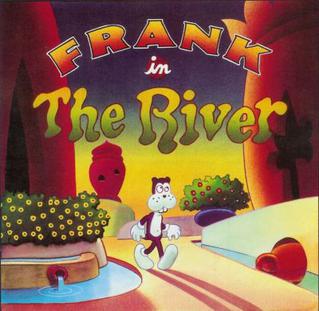
Frank in the River is a 24-page comic story by Jim Woodring.

Alan Moore is an English author known primarily for his work in comic books including Watchmen, V for Vendetta, The Ballad of Halo Jones, Swamp Thing, Batman: The Killing Joke, and From Hell. He is widely recognised among his peers and critics as one of the best comic book writers in the English language. Moore has occasionally used such pseudonyms as Curt Vile, Jill de Ray, Brilburn Logue, and Translucia Baboon; also, reprints of some of his work have been credited to The Original Writer when Moore requested that his name be removed.
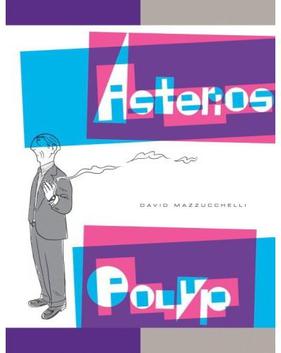
Asterios Polyp is a 2009 graphic novel by American cartoonist David Mazzucchelli.

Congress of the Animals is a graphic novel by American artist Jim Woodring published on June 8, 2011. The book is Woodring's second book-length comic set in his fictional world, the Unifactor, and the first to star his most famous character, Frank.

The wordless novel is a narrative genre that uses sequences of captionless pictures to tell a story. As artists have often made such books using woodcut and other relief printing techniques, the terms woodcut novel or novel in woodcuts are also used. The genre flourished primarily in the 1920s and 1930s and was most popular in Germany.
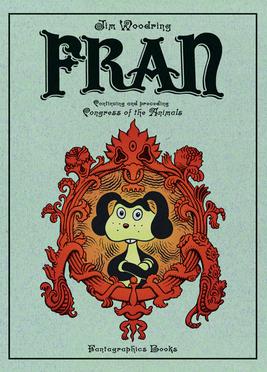
Fran is a graphic novel by American cartoonist Jim Woodring released in 2013. The wordless book is the third Frank graphic novel, following Weathercraft (2010) and Congress of the Animals (2011). After the anthropomorphic Frank violently loses his self-control with his secretive female counterpart Fran, whom he discovered at the end of Congress of the Animals, she leaves him, and he sets out in search of her.




















